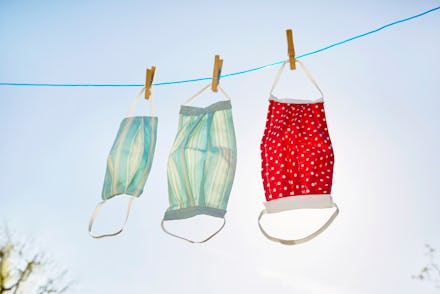You're probably cleaning your face masks wrong

Like many of us living in this pandemic, I consider my cloth mask a staple item, as essential to have on me when I head out the door as my phone, keys, and wallet. Although masks can help protect us and those around us from COVID-19, the contamination that occurs when we wear them out can limit their ability to do so. I try to wash my mask with dish soap and hot water as soon as I get home, but occasionally I forget, and worry about whether my precautions go far enough. How do I clean my mask so that it actually serves its purpose?
The Centers for Disease Control and Prevention recommends wearing masks in public places to prevent those infected with the novel coronavirus, who may or may not show symptoms, from exhaling their virus-laden droplets onto others. Masks, then, can help slow the transmission of COVID-19. Growing evidence that the virus remains airborne indoors only underscores their importance.
To learn how to best keep my mask clean, I turned to medical experts. In general, they recommend treating your face mask like you would your underwear: If you’re wearing it for full, 8- to 12-hour days, “you want to make sure you have a fresh one every day,” says Jade Flinn, the nurse educator for the Johns Hopkins Biocontainment Unit. Seriously, think about all the moisture and germs that’ve accumulated on your mask, not only on the outside, but the inside, as well. “I think we forget that we are creating our own schmutz on the inside of the mask" — and that schmutz can create the ideal environment for germs to thrive.
On the other hand, if the only time you masked up on a given day was to drop off mail or run some other quick errand, you probably don’t need to wash it before wearing it again the next day, Flinn says. But “if you’re taking care of somebody who is COVID-positive, and they’re coughing, you should be changing your mask after each encounter,” Suzanne Willard, a clinical professor and associate dean for global health at Rutgers School of Nursing, tells me.
All of this comes with the caveat that there isn’t any research data indicating how frequently you need to wash your mask, she adds, but given all the unknowns, you might want to err on the side of caution. The important thing is that you actually wear your mask; cleaning it on the regular shouldn’t be so complicated or stressful that you say "screw it" and neglect to wear it altogether.
However you wash your mask, Flinn suggests using heat — which can break down viral particles — and vigorous washing with detergent, dish soap, or any soap with disinfectant properties — which can degrade the viral particles’ protective outer envelope. So if you handwash your mask, give it a good scrub in soap and hot water (boiling water if you’ve been in contact with someone who’s tested positive for COVID), Willard says. “That’ll loosen up any debris.”
If you launder your mask, she recommends doing so separately from your other dirty clothes to avoid contaminating them. Maybe wash it with your other masks, if you have multiple — after all, “you wouldn’t wash dirty diapers with the rest of your laundry.” Set the drier heat to the highest setting, Flinn says, or hang-dry the mask under direct sunlight, which has been shown to lower viral durability.
Make sure your mask dries completely before you wear it again, since putting a damp cloth on your face will further dampen it when you breathe and talk, breeding more bacteria, Flinn explains. To avoid this, wash your mask as soon as you can to allow it enough time to dry before your next use, or buy multiple masks, so you have at least one clean one to wear while the other is drying.
The hot, humid environment a mask can create, combined with dirt from your mask and skin, can clog your pores and lead to breakouts, a.k.a. “maskne,” according to the experts I spoke to. So, besides aiding in slowing the transmission of COVID-19, proper mask washing — paired with good skincare — can help ward off this annoying problem. Also, try not to touch your face, Flinn notes, which might be harder to do now that a mask is making you more conscious of it. “All of those small movements are ways you can transmit bacteria or debris onto your face.”
In light of my conversations with Flinn and Willard, I’ll probably invest in another mask. I rarely venture out, but an extra mask could come in handy if I fall behind on washing the one I currently own. Just like maintaining my distance from others, I want to learn to accept mask washing as part of the new normal and make it as easy for myself as possible.